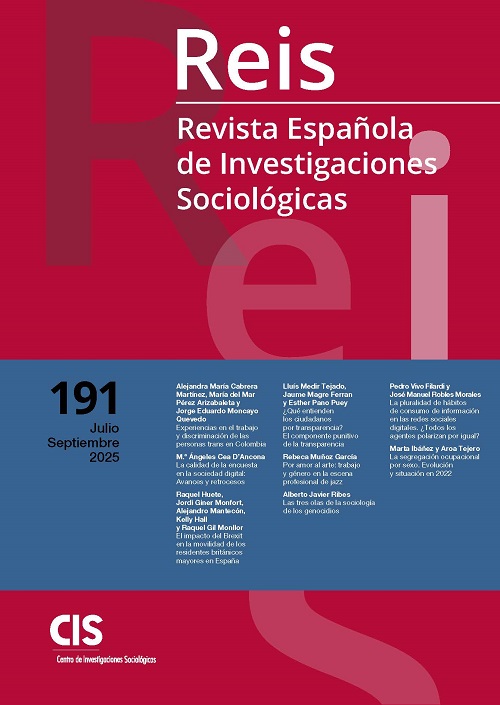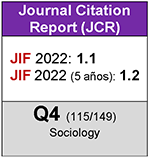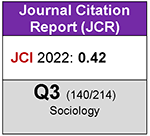The Plurality of Information Consumption Habits on Digital Social Networks. Are All Media Agents Equally Polarising?
DOI:
https://doi.org/10.5477/cis/reis.191.113-128Keywords:
Echo Chambers, Information Environment, Selective Exposure, Opinion Leaders, Alternative Media, Polarisation, TwitterAbstract
In studies on political polarization, attention has been drawn to the potential negative impact of the increasing prevalence of media outlets and diverse information and opinion consumption choices. The theories of selective exposure and findings regarding the presence of echo chambers on social networks allow us to characterize some of the dynamics that arise in the new informational environments of the digital era. Whether information and opinion exposure are effectively polarized along partisan lines is a question whose answer depends, in part, on the methodologies and information sources considered. In this research, the information exposure preferences of a sample of politicized users on the social network Twitter have been studied. The various agents in the informational environment, ranging from traditional media to new alternative opinion leaders, have been used as the variable of interest. To analyze the degree of polarization, a network of duplicated friendship relationships has been constructed to assess patterns of shared audiences in users' deliberate exposure. The structure of exposure reveals a strong partisan polarization, mainly around the left-right axis. On the other hand, it has been observed that the new agents have more polarized audiences than traditional ones, suggesting an incentive to adopt more radical political positions. The results underscore the relevance of the informational environment in political polarization processes.
Downloads
References
Adamic, Lada A. y Glance, Natalie (2005). «The political blogosphere and the 2004 US election: divided they blog». En: Proceedings of the 3rd international workshop on Link discovery (pp. 36-43).
Aragón, Pablo; Kappler, Karolin Eva; Kaltenbrunner, Andreas; Laniado, David y Volkovich, Yana (2013). «Communication dynamics in Twitter during political campaigns: The case of the 2011 Spanish national election». Policy & internet, 5 (2): 183-206.
Bakshy, Eytan; Messing, Solomon y Adamic, Lada A. (2015). «Exposure to ideologically diverse news and opinion on Facebook». Science, 348 (6239): 1130-1132.
Barberá, Pablo; Jost, John T.; Nagler, Jonathan; Tucker, Joshua A. y Bonneau, Richard (2015). «Tweeting from left to right: Is online political communication more than an echo chamber?». Psychological science, 26 (10): 1531-1542.
Bastos, Marco T. y Mercea, Dan (2016). «Serial activists: Political Twitter beyond influentials and the twittertariat». New Media & Society, 18 (10): 2359-2378.
Bruns, Axel (2017). «Echo chamber? What echo chamber? Reviewing the evidence». En: 6th Biennial Future of Journalism Conference (FOJ17).
Cinelli, Matteo; De Francisci Morales, Gianmarco; Galeazzi, Alessandro; Quattrociocchi, Walter y Starnini, Michele (2021). «The echo chamber effect on social media». Proceedings of the National Academy of Sciences, 118 (9): e2023301118.
Conover, Michael; Gonçalves, Bruno; Flammini, Alessandro y Menczez, Filippo (2012). «Partisan asymmetries in online political activity.» EPJ Data Science, 1(6): 1-19.
Dahlgren, Peter M. (2022). «Forced versus selective exposure: Threatening messages lead to anger but not dislike of political opponents.» Journal of Media Psychology: Theories, Methods, and Applications, 34 (3): 150.
Del Valle, Marc Esteve y Borge Bravo, Rosa (2018). «Echo chambers in parliamentary Twitter networks: The Catalan case». International journal of communication, 12: 21.
Dokuka, Sofia; Koltcov, Sergei; Koltsova, Olessia y Koltsov, Maxim (2018). «Echo chambers vs opinion crossroads in news consumption on social media». En: International Conference on Analysis of Images, Social Networks and Texts, (pp. 13-19).
Dubois, Elizabeth y Gaffney, Devin (2014). «The multiple facets of influence: Identifying political influentials and opinion leaders on Twitter». American behavioral scientist, 58 (10): 1260-77.
Festinger, Leon (1957). A theory of cognitive dissonance (vol. 2). California: Stanford university press.
Garimella, Kiran; De Francisci Morales, Gianmarco; Gionis, Aristides y Mathioudakis, Michael (2018). «Political discourse on social media: Echo chambers, gatekeepers, and the price of bipartisanship». En: Proceedings of the 2018 world wide web conference, (pp. 913-922).
Garrett, R. Kelly (2009). «Echo chambers online?: Politically motivated selective exposure among Internet news users». Journal of computer-mediated communication, 14 (2): 265-285.
Garrett, R. Kelly; Carnahan, Dustin y Lynch, Emily K. (2013). «A turn toward avoidance? Selective exposure to online political information, 2004-2008». Political Behavior, 35 (1): 113-134.
Geiß, Stefan; Magin, Melanie; Jürgens, Pascal y Stark, Birgit (2021). «Loopholes in the echo chambers: How the echo chamber metaphor oversimplifies the effects of information gateways on opinion expression». Digital Journalism, 9 (5): 660-686.
Gentzkow, Matthew y Shapiro, Jesse M. (2011). «Ideological segregation online and offline». The Quarterly Journal of Economics, 126 (4): 1799-1839.
Grömping, Max (2014). «‘Echo chambers’ partisan facebook groups during the 2014 Thai election». Asia Pacific Media Educator, 24 (1): 39-59.
Habermas, Jurgen (1991). The structural transformation of the public sphere: An inquiry into a category of bourgeois society. MIT press.
Hacker, Kenneth L. y Dijk, Jan van (2000). Digital democracy: Issues of theory and practice. New York: Sage Publishing.
Hopkins, Daniel J. y McDonald Ladd, Jonathan (2013). «The consequences of broader media choice: Evidence from the expansion of Fox News». Available at SSRN 2070596.
Iyengar, Shanto; Sood, Gaurav y Lelkes, Yphtach (2012). «Affect, not ideologya social identity perspective on polarization». Public opinion quarterly, 76 (3): 405-431.
Johnson, Thomas J.; Bichard, Shannon L. y Zhang, Weiwu (2009). «Communication communities or “cyberghettos?”: A path analysis model examining factors that explain selective exposure to blogs». Journal of Computer-Mediated Communication, 15 (1): 60-82.
Klapper, Joseph T. (1960). The effects of mass communication. New York: Free Press.
Lee, Francis; Hai Liang, LF y KY Tang, Gary (2019). «Online incivility, cyberbalkanization, and the dynamics of opinion polarization during and after a mass protest event». International Journal of Communication, 13: 20.
Light, Ben (2014). Disconnecting with Social Networking Sites. London: Palgrave Macmillan UK.
McPherson, Miller; Smith-Lovin, Lynn y Cook, James M. (2001). «Birds of a feather: Homophily in social networks». Annual review of sociology, 27: 415-444.
Merten, Lisa (2021). «Block, hide or follow–personal news curation practices on social media». Digital Journalism, 9 (8): 1018-1039.
Metzger, Miriam J.; Hartsell, Ethan H. y Flanagin, Andrew J. (2020). «Cognitive dissonance or credibility? A comparison of two theoretical explanations for selective exposure to partisan news». Communication Research, 47 (1): 3-28.
Molyneux, Logan (2015). «What journalists retweet: Opinion, humor, and brand development on Twitter». Journalism, 16 (7): 920-935.
Müller, Philipp y Schulz, Anne (2021). «Alternative media for a populist audience? Exploring political and media use predictors of exposure to Breitbart, Sputnik, and Co.». Information, Communication & Society, 24 (2): 277-293. doi: 10.1080/1369118X.2019.1646778
Mutz, Diana C. (2002). «Cross-cutting social networks: Testing democratic theory in practice». American Political Science Review, 96 (1): 111-126.
Negredo, Samuel; Martínez-Costa, María-Pilar; Breiner, James y Salaverría, Ramón (2020). «Journalism expands in spite of the crisis: Digital-native news media in Spain». Media and communication, 8 (2): 73-85.
Pariser, Eli (2012). The Filter Bubble: What The Internet Is Hiding From You. London: Penguin.
Parmelee, John H. y Roman, Nataliya (2020). «Insta-echoes: Selective exposure and selective avoidance on Instagram». Telematics and Informatics, 52: 101432. doi: 10.1016/j.tele.2020.101432
Peterson, Erik; Goel, Sharad y Iyengar, Shanto (2021). «Partisan selective exposure in online news consumption: Evidence from the 2016 presidential campaign». Political science research and methods, 9 (2): 242-258.
Prior, Markus (2005). «News vs. entertainment: How increasing media choice widens gaps in political knowledge and turnout». American Journal of Political Science, 49 (3): 577-592.
Quattrociocchi, Walter; Scala, Antonio y Sunstein, Cass R. (2016). «Echo chambers on Facebook». Available at SSRN 2795110.
Robles, José Manuel; Atienza, Julia; Gómez, Daniel y Guevara, Juan Antonio (2019). «La polarización de “La Manada”: el debate público en España y los riesgos de la comunicación política digital». Tempo Social, 31 (3): 193-216. doi: 10.11606/0103-2070.ts.2019.159680
Skovsgaard, Morten; Shehata, Adam y Strömbäck, Jesper (2016). «Opportunity Structures for Selective Exposure: Investigating Selective Exposure and Learning in Swedish Election Campaigns Using Panel Survey Data». The International Journal of Press/Politics, 21 (4): 527-546. doi: 10.1177/1940161216658157
Spohr, Dominic (2017). «Fake news and ideological polarization: Filter bubbles and selective exposure on social media». Business information review, 34 (3): 150-160.
Stroud, Natalie Jomini (2008). «Media use and political predispositions: Revisiting the concept of selective exposure». Political Behavior, 30 (3): 341-366.
Stroud, Natalie Jomini (2017). «531Selective Exposure Theories». En: The Oxford Handbook of Political Communication. Oxford: Oxford University Press.
Sunstein, Cass R. (2018). # Republic: Divided democracy in the age of social media. Princeton: Princeton University Press.
Terren, Ludovic y Borge-Bravo, Rosa (2021). «Echo chambers on social media: a systematic review of the literature». Review of Communication Research, 9: 99-118.
Thorson, Kjerstin y Wells, Chris (2016). «Curated Flows: A Framework for Mapping Media Exposure in the Digital Age». Communication Theory, 26 (3): 309-328. doi: 10.1111/comt.12087
Van Aelst, Peter; Strömbäck, Jesper; Aalberg, Toril; Esser, Frank; De Vreese, Claes; Matthes, Jörg; Hopmann, David; Salgado, Susana; Hubé, Nicolas; Stępińska, Agnieszka; Papathanassopoulos, Stylianos; Berganza, Rosa; Legnante, Guido; Reinemann, Carsten; Sheafer, Tamir y Stanyer, James (2017). «Political communication in a high-choice media environment: a challenge for democracy?». Annals of the International Communication Association, 41 (1): 3-27.
Webster, James G. (2005). «Beneath the veneer of fragmentation: Television audience polarization in a multichannel world». Journal of Communication, 55 (2): 366-382.
Webster, James G. y Ksiazek, Thomas B. (2012). «The Dynamics of Audience Fragmentation: Public Attention in an Age of Digital Media». Journal of Communication, 62 (1): 39-56. doi: 10.1111/j.1460-2466.2011.01616.x
Weeks, Brian E.; Ksiazek, Thomas B. y Holbert, R. Lance (2016). «Partisan enclaves or shared media experiences? A network approach to understanding citizens’ political news environments». Journal of Broadcasting & Electronic Media, 60 (2): 248-268.
Williams, Hywel TP; McMurray, James R.; Kurz, Tim y Lambert, F. Hugo (2015). «Network analysis reveals open forums and echo chambers in social media discussions of climate change». Global environmental change, 32: 126-138.
Downloads
Published
How to Cite
Issue
Section
License
Copyright (c) 2024 Revista Española de Investigaciones Sociológicas

This work is licensed under a Creative Commons Attribution-ShareAlike 4.0 International License.
Permite Compartir — copiar y redistribuir el material en cualquier medio o formato, Adaptar — remezclar, transformar y construir a partir del material para cualquier propósito, incluso comercialmente.








